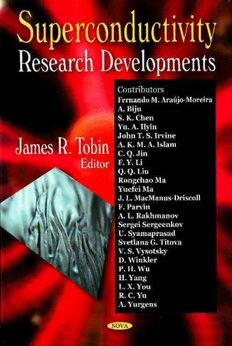Download Superconductivity Research Developments PDF Free - Full Version
Download Superconductivity Research Developments by James R. Tobin in PDF format completely FREE. No registration required, no payment needed. Get instant access to this valuable resource on PDFdrive.to!
About Superconductivity Research Developments
Superconductivity is a phenomenon occurring in certain materials at extremely low temperatures, characterized by exactly zero electrical resistance and the exclusion of the interior magnetic field (the Meissner effect). The electrical resistivity of a metallic conductor decreases gradually as the temperature is lowered. However, in ordinary conductors such as copper and silver, impurities and other defects impose a lower limit. Even near absolute zero a real sample of copper shows a non-zero resistance. The resistance of a superconductor, on the other hand, drops abruptly to zero when the material is cooled below its 'critical temperature', typically 20 kelvin or less. An electrical current flowing in a loop of superconducting wire can persist indefinitely with no power source. Like ferromagnetism and atomic spectral lines, superconductivity is a quantum mechanical phenomenon. It cannot be understood simply as the idealisation of 'perfect conductivity' in classical physics. Superconductivity occurs in a wide variety of materials, including simple elements like tin and aluminium, various metallic alloys and some heavily-doped semiconductors. Superconductivity does not occur in noble metals like gold and silver, nor in most ferromagnetic metals. In 1986 the discovery of a family of cuprate-perovskite ceramic materials known as high-temperature superconductors, with critical temperatures in excess of 90 kelvin, spurred renewed interest and research in superconductivity for several reasons. As a topic of pure research, these materials represented a new phenomenon not explained by the current theory. And, because the superconducting state persists up to more manageable temperatures, more commercial applications are feasible, especially if materials with even higher critical temperatures could be discovered. This new book presents leading research from around the world in this dynamic field.
Detailed Information
| Author: | James R. Tobin |
|---|---|
| Publication Year: | 2008 |
| ISBN: | 9781600218484 |
| Pages: | 264 |
| Language: | English |
| File Size: | 6.629 |
| Format: | |
| Price: | FREE |
Safe & Secure Download - No registration required
Why Choose PDFdrive for Your Free Superconductivity Research Developments Download?
- 100% Free: No hidden fees or subscriptions required for one book every day.
- No Registration: Immediate access is available without creating accounts for one book every day.
- Safe and Secure: Clean downloads without malware or viruses
- Multiple Formats: PDF, MOBI, Mpub,... optimized for all devices
- Educational Resource: Supporting knowledge sharing and learning
Frequently Asked Questions
Is it really free to download Superconductivity Research Developments PDF?
Yes, on https://PDFdrive.to you can download Superconductivity Research Developments by James R. Tobin completely free. We don't require any payment, subscription, or registration to access this PDF file. For 3 books every day.
How can I read Superconductivity Research Developments on my mobile device?
After downloading Superconductivity Research Developments PDF, you can open it with any PDF reader app on your phone or tablet. We recommend using Adobe Acrobat Reader, Apple Books, or Google Play Books for the best reading experience.
Is this the full version of Superconductivity Research Developments?
Yes, this is the complete PDF version of Superconductivity Research Developments by James R. Tobin. You will be able to read the entire content as in the printed version without missing any pages.
Is it legal to download Superconductivity Research Developments PDF for free?
https://PDFdrive.to provides links to free educational resources available online. We do not store any files on our servers. Please be aware of copyright laws in your country before downloading.
The materials shared are intended for research, educational, and personal use in accordance with fair use principles.

